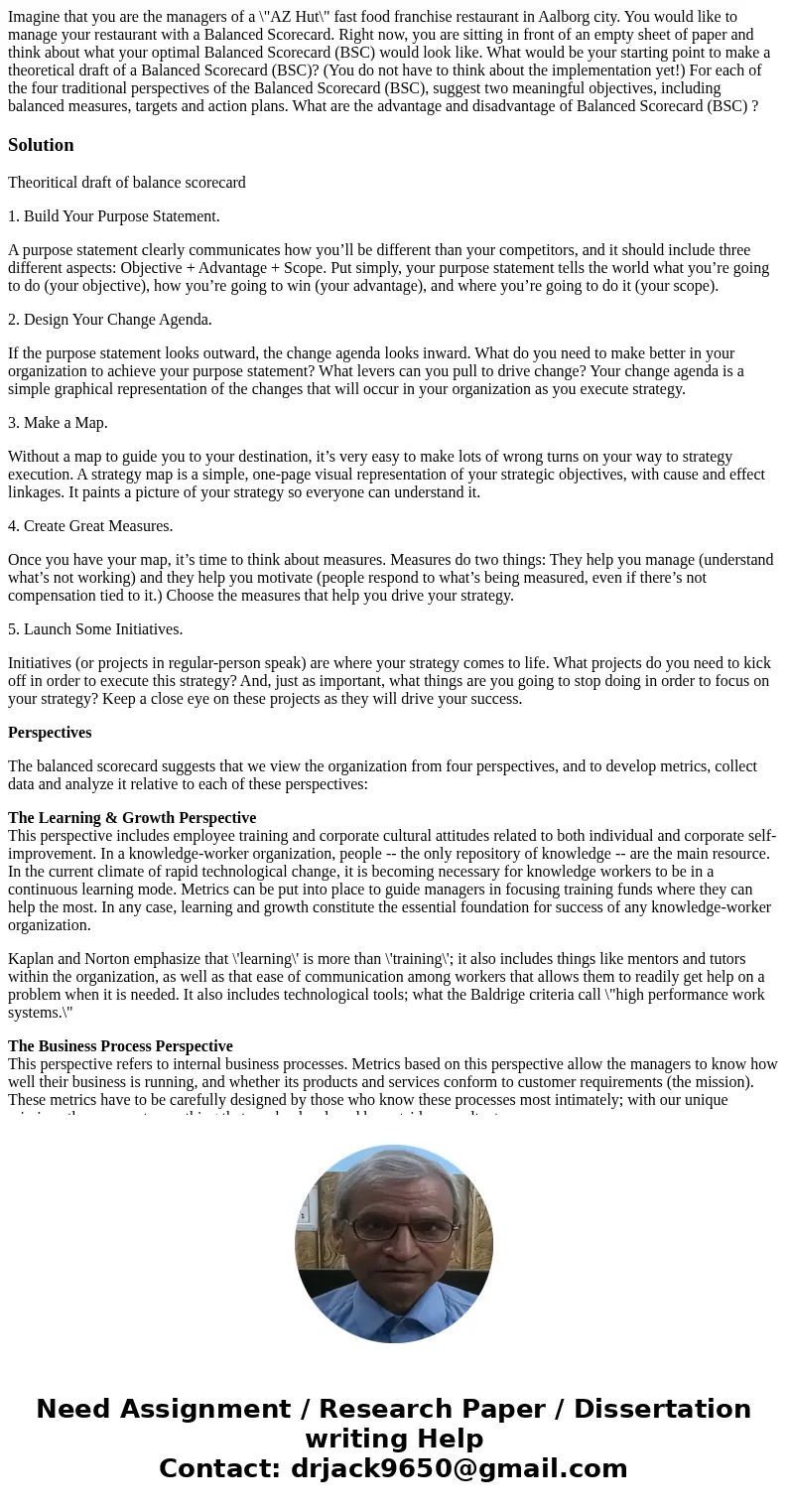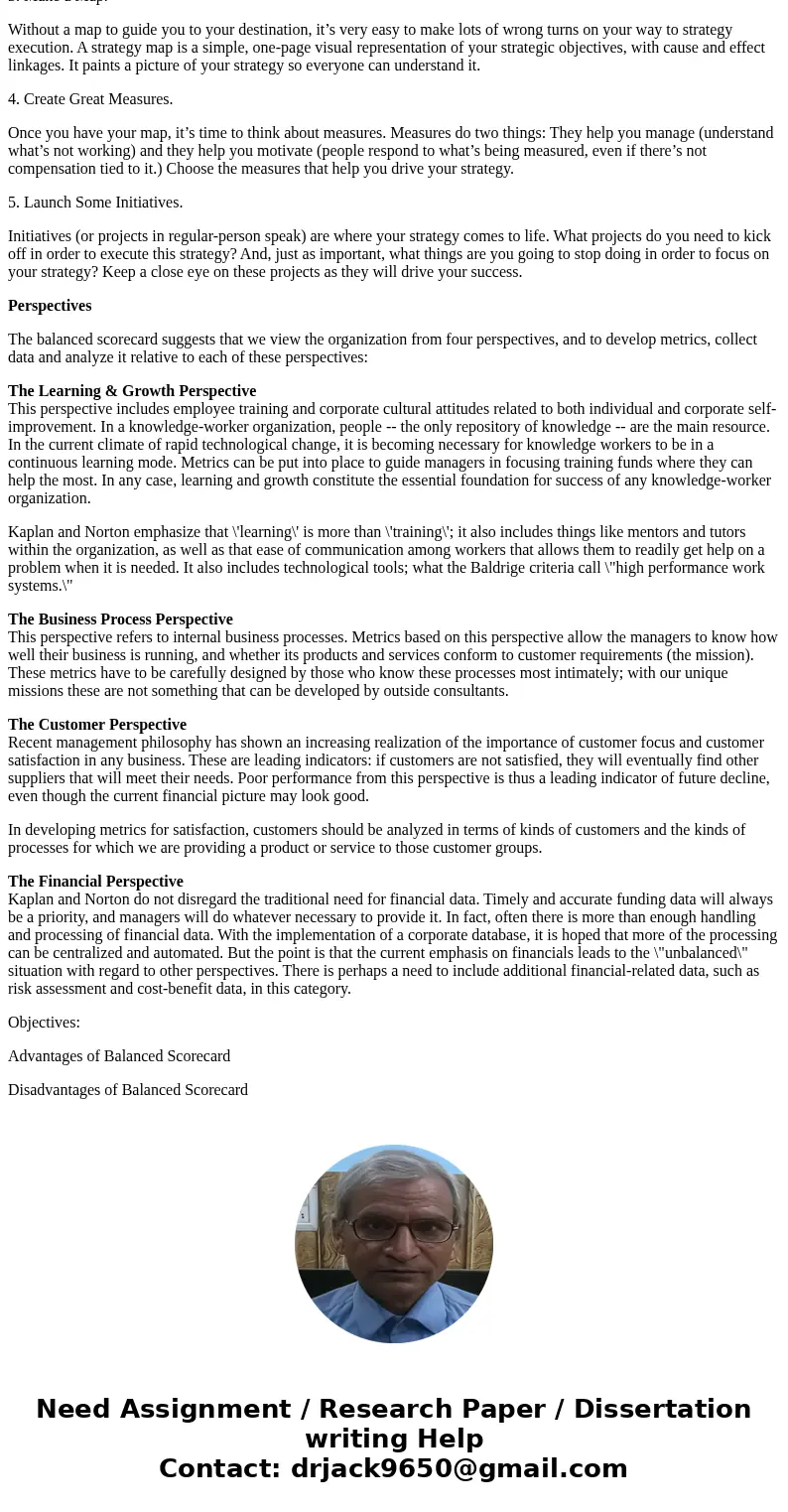Imagine that you are the managers of a AZ Hut fast food fran
Solution
Theoritical draft of balance scorecard
1. Build Your Purpose Statement.
A purpose statement clearly communicates how you’ll be different than your competitors, and it should include three different aspects: Objective + Advantage + Scope. Put simply, your purpose statement tells the world what you’re going to do (your objective), how you’re going to win (your advantage), and where you’re going to do it (your scope).
2. Design Your Change Agenda.
If the purpose statement looks outward, the change agenda looks inward. What do you need to make better in your organization to achieve your purpose statement? What levers can you pull to drive change? Your change agenda is a simple graphical representation of the changes that will occur in your organization as you execute strategy.
3. Make a Map.
Without a map to guide you to your destination, it’s very easy to make lots of wrong turns on your way to strategy execution. A strategy map is a simple, one-page visual representation of your strategic objectives, with cause and effect linkages. It paints a picture of your strategy so everyone can understand it.
4. Create Great Measures.
Once you have your map, it’s time to think about measures. Measures do two things: They help you manage (understand what’s not working) and they help you motivate (people respond to what’s being measured, even if there’s not compensation tied to it.) Choose the measures that help you drive your strategy.
5. Launch Some Initiatives.
Initiatives (or projects in regular-person speak) are where your strategy comes to life. What projects do you need to kick off in order to execute this strategy? And, just as important, what things are you going to stop doing in order to focus on your strategy? Keep a close eye on these projects as they will drive your success.
Perspectives
The balanced scorecard suggests that we view the organization from four perspectives, and to develop metrics, collect data and analyze it relative to each of these perspectives:
The Learning & Growth Perspective
This perspective includes employee training and corporate cultural attitudes related to both individual and corporate self-improvement. In a knowledge-worker organization, people -- the only repository of knowledge -- are the main resource. In the current climate of rapid technological change, it is becoming necessary for knowledge workers to be in a continuous learning mode. Metrics can be put into place to guide managers in focusing training funds where they can help the most. In any case, learning and growth constitute the essential foundation for success of any knowledge-worker organization.
Kaplan and Norton emphasize that \'learning\' is more than \'training\'; it also includes things like mentors and tutors within the organization, as well as that ease of communication among workers that allows them to readily get help on a problem when it is needed. It also includes technological tools; what the Baldrige criteria call \"high performance work systems.\"
The Business Process Perspective
This perspective refers to internal business processes. Metrics based on this perspective allow the managers to know how well their business is running, and whether its products and services conform to customer requirements (the mission). These metrics have to be carefully designed by those who know these processes most intimately; with our unique missions these are not something that can be developed by outside consultants.
The Customer Perspective
Recent management philosophy has shown an increasing realization of the importance of customer focus and customer satisfaction in any business. These are leading indicators: if customers are not satisfied, they will eventually find other suppliers that will meet their needs. Poor performance from this perspective is thus a leading indicator of future decline, even though the current financial picture may look good.
In developing metrics for satisfaction, customers should be analyzed in terms of kinds of customers and the kinds of processes for which we are providing a product or service to those customer groups.
The Financial Perspective
Kaplan and Norton do not disregard the traditional need for financial data. Timely and accurate funding data will always be a priority, and managers will do whatever necessary to provide it. In fact, often there is more than enough handling and processing of financial data. With the implementation of a corporate database, it is hoped that more of the processing can be centralized and automated. But the point is that the current emphasis on financials leads to the \"unbalanced\" situation with regard to other perspectives. There is perhaps a need to include additional financial-related data, such as risk assessment and cost-benefit data, in this category.
Objectives:
Advantages of Balanced Scorecard
Disadvantages of Balanced Scorecard


 Homework Sourse
Homework Sourse